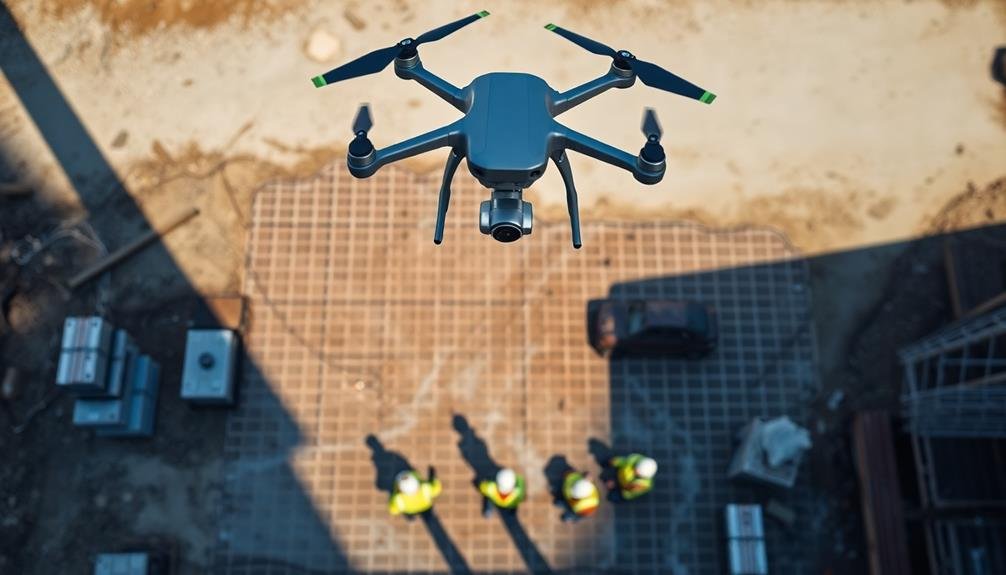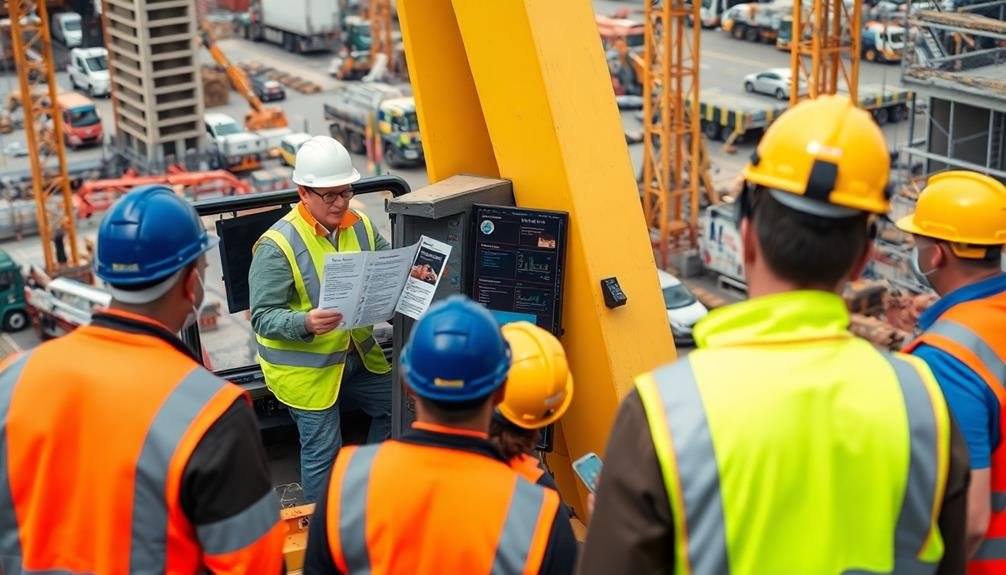To guarantee compliant construction site monitoring, you'll want to focus on five key areas. First, establish regular drone flight schedules for consistent progress tracking. Second, train your operators thoroughly on regulatory requirements, including FAA rules and local regulations. Third, implement robust data management protocols to organize and secure captured information. Fourth, maintain proper documentation and reporting practices, using standardized forms and digital systems. Finally, stay updated on regulatory changes by regularly checking official sources and joining industry associations. By following these tips, you'll enhance your compliance efforts and improve overall site monitoring effectiveness. Dive deeper to uncover the details of each strategy.
Establish Regular Drone Flight Schedules

Three key factors make regular drone flight schedules essential for effective construction site monitoring.
First, consistency allows you to track progress accurately over time, providing a reliable visual record of the project's development.
Second, it guarantees you capture all areas of the site systematically, reducing the risk of overlooking critical issues or potential hazards.
Third, it helps you optimize resource allocation by planning flights during ideal weather conditions and minimal site activity.
To establish an effective schedule, start by identifying your monitoring objectives and the frequency required to meet them.
Consider factors like project phase, site size, and regulatory requirements.
Next, create a flight plan that covers all areas of interest, including high-risk zones and areas prone to changes.
Coordinate with site managers to avoid conflicts with construction activities and guarantee safety protocols are in place.
Implement a system to review and analyze drone footage promptly after each flight.
This allows you to identify issues quickly and take corrective action.
Finally, be prepared to adjust your schedule as needed to accommodate unexpected events or changing project requirements.
Regular evaluation of your drone monitoring program will help you maintain compliance and maximize its effectiveness.
Train Operators on Regulatory Requirements

Establishing regular flight schedules is just one part of compliant drone operations. You'll also need to verify your operators are well-versed in regulatory requirements.
Start by familiarizing yourself with the FAA's Part 107 rules for commercial drone operations. These regulations cover essential aspects like pilot certification, aircraft registration, and operational limitations.
Train your operators on specific airspace restrictions and how to obtain necessary authorizations. They should understand visual line-of-sight requirements, maximum altitude limits, and weather condition assessments.
Emphasize the importance of maintaining a safe distance from people, vehicles, and structures.
Don't forget to cover privacy concerns and local regulations that may affect your construction site monitoring. Teach operators about proper pre-flight checks, emergency procedures, and incident reporting protocols.
Regularly update your training program to reflect any changes in regulations or best practices.
Implement a system for tracking operator certifications and verifying they remain current. Consider partnering with professional drone training organizations to provide thorough instruction.
Implement Data Management Protocols

A mountain of data can quickly accumulate from your drone monitoring operations. To guarantee compliance and maximize efficiency, you'll need robust data management protocols.
Start by establishing a centralized storage system for all your drone-captured images, videos, and sensor data. Use cloud-based solutions with appropriate security measures to protect sensitive information.
Implement a standardized naming convention for files and folders to facilitate easy retrieval and organization. Create a metadata tagging system to categorize data by project, date, location, and other relevant parameters.
Set up automated backups to prevent data loss and guarantee redundancy. Develop a data retention policy that aligns with regulatory requirements and your company's needs.
Regularly archive or delete outdated information to maintain system performance. Implement access controls to restrict data visibility based on user roles and permissions.
Establish a process for data analysis and reporting. Use software tools to extract insights from your drone data, generate compliance reports, and track site progress.
Train your team on proper data handling procedures and regularly audit your data management practices to identify areas for improvement.
Maintain Proper Documentation and Reporting

Proper documentation and reporting form the backbone of compliant construction site monitoring. You'll need to establish a systematic approach to record-keeping, guaranteeing all relevant data is captured and easily accessible.
Start by creating standardized forms for daily logs, incident reports, and inspection checklists. These should cover key aspects like safety observations, environmental concerns, and progress updates.
Implement a digital documentation system to streamline the process and improve accuracy. This will help you maintain a centralized database of all site-related information, making it easier to generate reports and track trends over time.
Don't forget to include photographic evidence alongside written records, as visual documentation can be invaluable in demonstrating compliance.
Regularly review and update your documentation procedures to guarantee they align with current regulations and best practices. Train your team on proper reporting techniques and emphasize the importance of timely and accurate submissions.
Set up a schedule for periodic internal audits to verify the quality and completeness of your documentation.
Stay Updated on Regulatory Changes

Maneuvering the ever-changing landscape of construction regulations requires vigilance and proactivity. You must stay informed about updates to local, state, and federal regulations that affect your construction projects. Regularly check official government websites, subscribe to industry newsletters, and attend relevant conferences or workshops to keep your knowledge current.
Establish a system to track regulatory changes and their potential impact on your ongoing and future projects. Assign team members to monitor specific areas of regulation and report any updates. When new regulations are introduced, analyze how they'll affect your current practices and implement necessary changes promptly.
Consider these strategies to stay updated:
- Join professional associations that provide regulatory updates and interpretations
- Collaborate with legal experts specializing in construction law
- Utilize compliance management software to streamline regulatory tracking
Don't forget to communicate regulatory changes to your entire team. Conduct regular training sessions to guarantee everyone understands new requirements and how to implement them.
Frequently Asked Questions
How Do Weather Conditions Affect Drone Monitoring on Construction Sites?
Weather greatly impacts your drone monitoring. Wind can destabilize flights, rain may damage equipment, and extreme temperatures affect battery life. You'll need to plan around forecasts and adjust your monitoring schedule accordingly for safe, effective operations.
What Are the Best Drone Models for Construction Site Monitoring?
You'll find the DJI Phantom 4 RTK, Yuneec H520E, and Autel EVO II Pro excellent for construction site monitoring. They offer high-resolution cameras, long flight times, and obstacle avoidance. Consider your specific needs and budget when choosing.
How Can We Integrate Drone Data With Existing Project Management Software?
You can integrate drone data with project management software by using APIs or plugins. Export your drone footage and data, then import it into your software. Many platforms offer built-in integration features for seamless data synchronization.
What Insurance Considerations Are Necessary for Drone Operations on Construction Sites?
You'll need to secure liability insurance for your drone operations. It's essential to cover potential damages to property, injuries, and privacy violations. Don't forget to check if your existing policies already include drone coverage.
How Do We Address Privacy Concerns When Conducting Aerial Surveillance of Neighboring Properties?
You'll need to respect privacy laws and neighboring properties' rights. Notify adjacent landowners, limit data collection to your site, blur or remove identifiable features, and securely store footage. Always prioritize ethical and legal compliance.
In Summary
You've now got the key strategies for compliant construction site monitoring using drones. Remember to schedule regular flights, train your operators well, manage data effectively, keep thorough records, and stay on top of regulations. By following these tips, you'll guarantee your drone operations remain legal and efficient. Don't forget to regularly review and update your practices as technology and rules evolve. Stay safe and compliant in your aerial monitoring efforts!

As educators and advocates for responsible drone use, we’re committed to sharing our knowledge and expertise with aspiring aerial photographers.




Leave a Reply